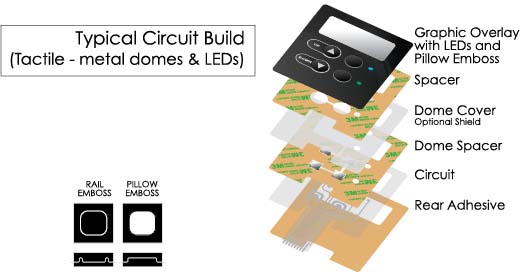Recognizing Membrane Switches: The Key to Reputable and long lasting Controls

What Are Membrane Buttons?
Membrane layer switches are an advanced remedy in the realm of individual interface modern technology, integrating performance and design perfectly. These tools function as an interface in between customers and electronic systems, incorporating numerous parts right into a portable format. Generally created from versatile, slim layers of materials, membrane switches are developed to react to touch, allowing individuals to interact with equipment and electronic gadgets efficiently.
The key elements of a membrane layer button consist of a published circuit layer, graphic overlay, and a spacer layer that protects against unexpected activation. The graphic overlay can be customized to show brand name identity or user choices, improving looks while making certain use. Membrane switches are generally used in various applications, including clinical devices, customer electronic devices, and commercial equipment, owing to their durability and resistance to ecological variables such as wetness and dust.
One of the key advantages of membrane layer buttons is their capacity to withstand damage, making them excellent for high-traffic environments. Furthermore, they are light-weight and need very little area, enabling cutting-edge styles in item development. Overall, membrane layer switches over stand for a reliable and sensible selection for contemporary digital interfaces, weding technology with user-centric design principles.
How Membrane Layer Changes Work
The procedure of membrane layer changes joints on a basic yet effective mechanism that translates user input into electronic signals. When a user presses the switch, the top layer flaws, enabling a conductive element in the circuit layer to make contact with an equivalent conductive pad on the bottom of the visuals overlay.
The style of membrane layer switches can vary, but they usually incorporate domes or tactile components to give responses to the user, enhancing the general experience - membrane switch. The materials utilized in membrane switches, such as polyester or polycarbonate, contribute to their toughness and resistance to ecological factors, including wetness and dirt. The published circuits are generally encapsulated, which safeguards them from wear and tear over time.
Advantages of Membrane Switches

Additionally, membrane switches are known for their resilience. Built from durable products, they are immune to dirt, wetness, and physical wear, which significantly prolongs their life-span compared to standard mechanical buttons. This resilience makes them specifically appropriate for high-traffic atmospheres and applications needing longevity.
Another considerable benefit is the convenience of cleansing and upkeep. The smooth surface of membrane changes lessens dirt buildup and is frequently resistant to spills, making them optimal for setups that call for constant sanitization.
Moreover, membrane layer buttons offer a streamlined account, bring about a thinner style that can be integrated into learn this here now various gadgets without including bulk. This function not only enhances the visual charm but also adds to a much more ergonomic product layout.
Applications of Membrane Layer Switches
Easy to use and versatile, membrane layer buttons find applications throughout a large range of sectors, consisting of medical tools, consumer electronic devices, and industrial equipment. In the clinical field, these buttons are essential to tools such as diagnostic equipment, individual monitoring systems, and mixture pumps, where reliability and convenience of cleaning are critical. Their capability to endure rough atmospheres and keep capability makes them optimal for such applications.

In customer electronic devices, membrane switches are made use of in products like microwaves, washing equipments, and remote controls - membrane switch. Their smooth layout allows for user-friendly interface, enhancing the overall individual experience while giving sturdiness and resistance to tear and wear
Industrial devices additionally gains from membrane buttons, specifically in control panels for machinery and automation systems. These switches provide security versus dirt and moisture, guaranteeing constant efficiency in tough settings. Furthermore, their customizable functions enable makers to customize them to details functional demands, enhancing efficiency and functionality.
Choosing the Right Membrane Switch
When selecting a membrane switch, it is vital to think about different variables that affect efficiency and suitability for particular applications. The primary considerations include ecological problems, responsive comments, sturdiness, and design specifications.
First, analyze the operating setting; buttons exposed to moisture, chemicals, or severe temperature levels require specific products to make sure longevity and functionality. Next off, assess the need for responsive comments. Depending on customer interaction, some applications may take advantage of a tactile response to verify activation, while others may favor a non-tactile style for aesthetic factors.
Sturdiness is another essential aspect; membrane buttons should be made to stand my website up to frequent usage, impacts, and abrasion. Make sure the selected button can endure the anticipated lifecycle, particularly in high-usage circumstances.

Conclusion
In conclusion, membrane changes offer as important elements in the layout of resilient and trustworthy control systems throughout various industries. The adaptability of membrane switches enables for tailored options that fulfill specific functional needs, reinforcing their relevance in modern-day innovation.
Membrane switches over hop over to here represent an essential element of modern interface layout, blending functionality with strength in various applications.Membrane layer switches are an innovative service in the realm of user interface technology, integrating performance and style seamlessly. Normally built from versatile, slim layers of materials, membrane layer buttons are created to respond to touch, allowing individuals to engage with machinery and digital tools effectively.
The style of membrane buttons can differ, however they frequently include domes or tactile components to supply feedback to the individual, improving the overall experience.In verdict, membrane layer changes offer as vital elements in the design of dependable and long lasting control systems across numerous industries.